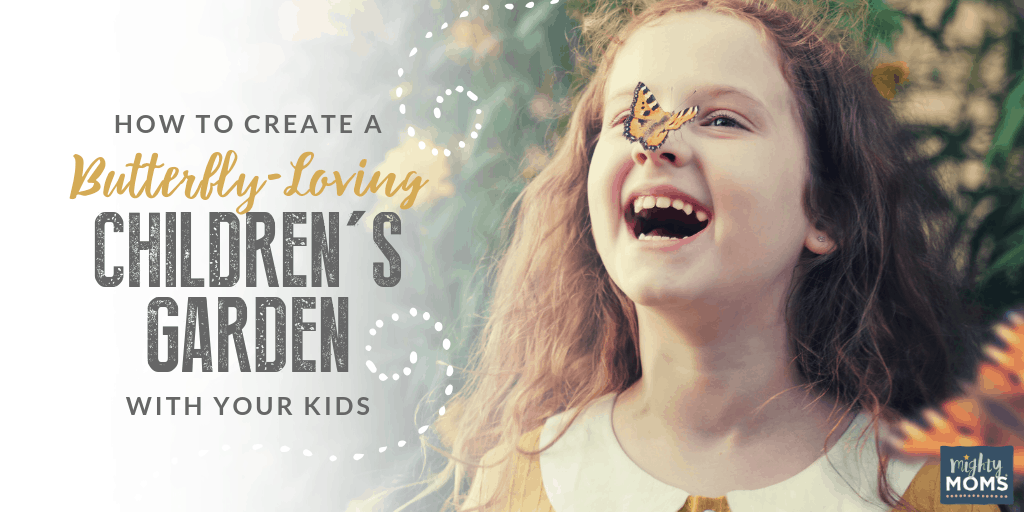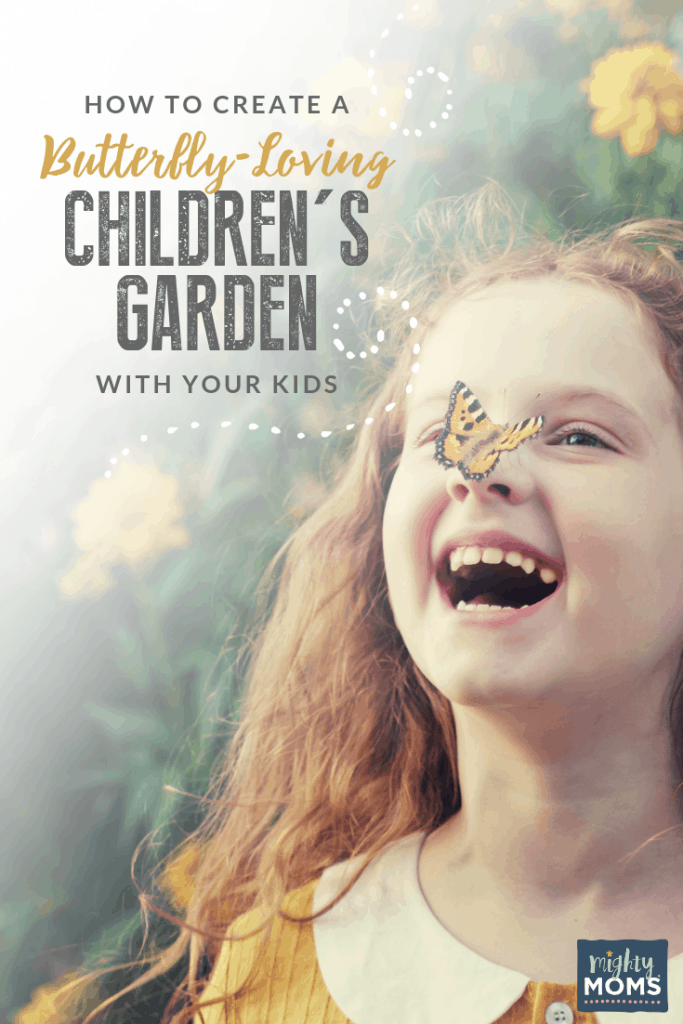You know the story.
It starts with a little egg on a leaf but soon our very hungry friend goes on a long journey to find the right food to fill his tummy. He searches high and low, eating everything disagreeable in sight, until he comes to a nice, green leaf.
What if I told you your own backyard could be home to a whole host of nice, green leaves to feed very hungry caterpillars?
Good news! A caterpillar and butterfly friendly garden is within your reach! And, even better: Your kids can help too.
Planting a Children’s Garden
Doesn’t Have to Be Hard
A children’s garden doesn’t have to be anything big, expensive, or overwhelming. It just takes a few quick and easy steps:
- Choose the right space.
- Choose the right plants.
- Gather your gear.
- Plant your garden.
- Watch your garden grow. (Take LOTS of pictures.)
Children’s Garden Step 1:
Choose the Right Space
Our hungry caterpillar gets his start when one warm, sunny Sunday, he pops out of his egg on a leaf.
What does this have to do with our butterfly garden? You guessed it! Location is the first step in planting your garden.
You want a successful butterfly garden, so the location needs to be top notch and attractive to butterflies. Summon forth your best observation skills and get out those sunglasses. You’re going to need them to find just the right spot! Here’s what your butterfly-friendly children’s garden is going to need.
You’ll Need Sunshine
What part of your yard gets the most sun? Flowering plants need sun to grow and produce nectar, and butterflies need sunshine to stay warm.
If you have a spot that is a bit overgrown but mostly full sun, try some garden shears like these to tame the backyard jungle before you get started.
You’ll Need Yard Space
Do you have a roomy yard where you can dedicate space to an in-ground garden? When you’ve chosen the sunniest patch, make note of how well it drains (pour a bucket of water on it and see where the water goes) and how well any other vegetation grows.
You don’t want to choose the only spot in your yard that turns into a lake at the first sign of rain!
…Or At Least Several Plant-Happy Pots!
Is yard space at a premium for you? Maybe you don’t have a huge yard, but you have a porch, stoop, or corner in the sun you can spare. Try planting your garden in pots or containers, like these, instead of tilling up precious yard space in prime real estate.
Children’s Garden Step 2:
Choose the Right Plants
Hanging a welcome sign and decorative butterflies from trees or shepherd’s hooks might give your human visitors the impression that you’re awaiting caterpillar and butterfly VIPs, but the right way to invite a hungry caterpillar is by choosing the right plants. Here are the kinds of plants to look for.
Choose Plants that Are Colorful
What does a garden have in common with a crayon box? Lots of colors!
Recruit your kids to choose a wide variety of colorful plants that support all phases of the butterfly’s life cycle. Some favorites with bright blossoms are azaleas, coneflowers, and zinnias.
It’s also worth exploring your local botanical garden’s recommendations for plants native to your area. You can find the garden closest to you using this map.
Choose Plants That Are Natural Protectors
You won’t want to use any pesticides on these plants to repel nasty bugs because the same pesticides will hurt your butterfly population, too. Instead try a variety of marigolds, mint, and petunias among your other choices to naturally repel any pests lurking about.
A word about mint: It’s edible and delicious, but also very invasive. We suggest planting mint in its own container, even if you are planting the rest of your garden directly into the ground. Mint will grow to fit the size of wherever you plant it, meaning you can have one pot of it…or an entire yard.
Looking for more than just butterflies? Try hanging one of these hummingbird feeders and filling it with a sweet solution to encourage those tiny beauties to flit about with the butterflies.
Children’s Garden Step 3:
Gather Your Gear
It’s easy to involve your kids in planting the garden, even if your own little caterpillars don’t love dirt. Just make sure you get a few gardening gear essentials.
Well-Fitting Gardening Gloves
Gardening gloves aren’t just for looks, they protect hands from anything sharp or bacteria laden (hello stray cats!) in your garden while digging. Try these gloves, perfect for little hands and in a variety of colors.
Helpful Garden Tools
Digging with tools will make for light work. It’s similar to digging in sand, but a great opportunity to teach digging with purpose. This is a great set of tools, complete with its own caddy.
Smart Skin Protection
It’s easy to pass the day away when the weather is beautiful and the sun in high working in the garden. It’s also really easy to get sunburned. Protect your little ones skin with sunhats (SPF included!), stylish sunglasses, and a good sunblock.
Also, a spritz of kid friendly bug spray will protect everyone from bites and stings while they work.
Children’s Garden Step 4:
Plant Your Garden
Armed with their garden gear, your kids can really dig deep and make their garden their own.
Why not roll up your sleeves with them and dig in? Here are a few tips to keep in mind:
Go for Goldilocks Soil
Whether you use the existing soil in your yard, purchase a potting mix like this one, or get your local nursery’s recommendation, you’ll need to do a little prep work before you plant.
Make sure your soil is kind of like Goldilocks’ soil: not too packed down but not too loose, not too dry but not too wet. You want your soil just right. You can judge this for yourself, or, if you want to get really serious and high tech, can test your soil with this gadget.
Dig Deep (But Not Too Deep!)
Most flower seeds only need to be about ¼ of an inch under the ground. Your kids can dig rows with their garden tools or just use a finger to make a divot for the seeds.
Sow Seeds to Improve Development
This activity is fantastic for helping strengthen a pincer grasp and hand eye coordination. Shake a few seeds out of the envelope into the palm of your child’s hand, and let them pinch some seeds between their fingers and choose where in the row to place them.
Make note of what is planted where with these simple labels, so your kids can easily see the result of their hard work!
Watering Rocks! (But Perhaps Not Literally)
Now that the seeds are in the ground, your little caterpillars can finish the task by watering what they’ve planted. Be careful not to overwater, especially right away, so the seeds don’t wash away!
Your little ones are going to want to overwater, so if you see they’re getting too overzealous, perhaps point them towards the gravel driveway instead. It looks thirsty!
Your seed packets or seedling stakes should have information about how often each plant needs watering. Always work together with the weather, too. If you’ve had a lot of rain, no need to send your little ones out with their elephant-shaped watering can!
Children’s Garden Step 5:
Watch Your Garden Grow
Now that the literal dirty work is done, it’s time to enjoy the fruits of your labor. You can sit back, relax, and watch your garden grow.
Be sure you’re watering and weeding as directed by your seed packets, and, if you’ve chosen a sunny enough spot, it shouldn’t be too long before those flowers start sprouting.
Here are some fun ways to keep your kids involved in the growth process:
- Keep a diary: if you have some data-minded kids or would like to encourage a data gathering perspective, a log book like this one is a great place to record the day to day garden observations. It’s full of prompts to help them care for their garden and record what they’re learning during the process.
- Take a closer look: This fun snake-themed magnifying glass is perfect to help see those shoots and leaves in your garden. Are they budding? What do the buds look like? Are there any bugs that have moved in?
- Take photographic evidence: Use your phone or get this fun throwback camera to document the growth of your garden and any critters who move in!
- Bring in more bugs: Vermicomposting is a fun, gross, and eco friendly way to feed your garden. Get the entire kit here, and feed your worms kitchen scraps and paper products. The worms digest what you feed them, leaving behind rich food for your garden.
Stop and Smell the Flowers…
And Get Some Butterfly Kisses!
A children’s butterfly garden is a great way to show your kids the fruits of their labor, and a well curated butterfly garden will be bright and vibrant, buzzing with insect life.
Your little gardeners can plant, water, and watch as their garden comes to life, and feel accomplished knowing they’ve provided many tasty green leaves for some very hungry caterpillars.
Have You Read These Yet?
- The Best Rain Gear for Kids: 15 Examples of Adorable Cuteness
- Taking the Kids to a Theme Park? 7 Miserable Mistakes You’ll Want to Avoid
- Mrs. Frizzles Cheap and Easy Guide to Magical Outdoor Play
- 4 Unique Road Trip Games That Will Distract Your Worst Complainers
We ♥ honesty! This post contains affiliate links that provide extra money for our mutual coffee habits addictions. Click here to learn more. As an Amazon Associate I earn from qualifying purchases.



